
This module illusrates navigation to and use of EBSCOhost from the Alabama Virtual Library. All videos are closed-captioned.
- Subject:
- Information Science
- Material Type:
- Module
- Author:
- Kelly Griffiths
- Date Added:
- 05/28/2019

This module illusrates navigation to and use of EBSCOhost from the Alabama Virtual Library. All videos are closed-captioned.
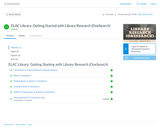
This is a Canvas module to help students become familiar with OneSearch, our library's discovery service. This includes finding books and articles in OneSearch, a video on using OneSearch, and a short quiz on using OneSearch.

This is a Canvas module to help students become familiar with using library databases and understand the utility in searching across multiple databases. Under "Choosing Library Databases: Subject-Specific Databases", faculty should choose the disciplinary page(s) that are most appropriate for their course.
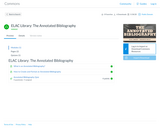
This is a Canvas module to help students become familiar with the genre of the annotated bibliography.
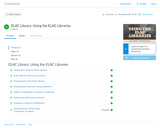
This is a Canvas module to help students become familiar with the libraries at East Los Angeles College. This module details available resources and services, a very basic introduction in how to find books and other materials at the library, information on how students can get help with research, a template for faculty to provide information on their textbook on reserve, and a short quiz on using the ELAC Libraries.

This links to a Slideshare presentation by Ian Brown which gives an overview of Big Data
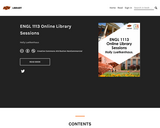
This resource is used to provide library instruction for introductory undergraduate composition courses.

The DMT Clearinghouse is a registry for online learning resources about research data management. Initial seed funding was provided by the U.S. Geological Survey's Community for Data Integration. Subsequent funding has been granted by an Institute of Museum and Library Services National Leadership Grant (LG-70-18-0092-18). Developed in collaboration with the Earth Sciences Information Partnership (ESIP) Federation, and DataONE, with subsequent support from the University of New Mexico Libraries Research Data Services, the DMT Clearinghouse is available for searching, browsing, and submitting information about learning resources on data management topics. DMT Clearinghouse FeaturesThe Search Interface allows users to find learning resources by entering terms, names of people and organizations, dates, and keywords. The Browse Interface allows users to view the entire list of learning resources, and to filter by educational framework. An educational framework is a plan or set of steps that defines or collects the content using clear, definable standards about what the student should know and understand. For purposes of the DMT Clearinghouse, a given learning resource may be associated with a community-defined standard for data management, for example:USGS Science Support FrameworkDataONE Data Life CycleESIP Data Management Short Course for Scientists The Digital Preservation NetworkInternational Council for Science (ICSU) World Data System (WDS) Training Resource GuideFAIR Data Principles The Submission Form allows users to enter information about learning resources that they would like to see included in the DMT Clearinghouse. A user log in is not required to submit a resource with key, required information. To add more information about a learning resource than just that required, please log in or create an account (click "Log In at the upper right side of the screen.) NOTE: Submissions will be published to the DMT Clearinghouse following an editorial review to ensure the resource meets quality and selection criteria for inclusion.. You may be contacted for more information about your submission, if needed. Your contact information will not be made available publicly without your permission. For questions or feedback, please contact clearinghouseEd@esipfed.org.
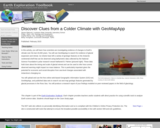
DATA: Global Digital Elevation Model (DEM) TOOLS: GeoMapApp, Spreadsheet SUMMARY: Use GeoMapApp to search for evidence of glacial expansion and retreat. Produce a research report of your findings modeled on peer-reviewed papers in the field of glaciology.
(Note: this resource was added to OER Commons as part of a batch upload of over 2,200 records. If you notice an issue with the quality of the metadata, please let us know by using the 'report' button and we will flag it for consideration.)
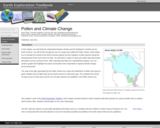
DATA: Pollen Viewer. TOOLS: Analyzing Digital Images, Spreadsheet. SUMMARY: Study the relationship between climate and the distribution of plants across North America, import data into spreadsheet and graph.
(Note: this resource was added to OER Commons as part of a batch upload of over 2,200 records. If you notice an issue with the quality of the metadata, please let us know by using the 'report' button and we will flag it for consideration.)

Game Theory, also known as Multiperson Decision Theory, is the analysis of situations in which the payoff of a decision maker depends not only on his own actions but also on those of others. Game Theory has applications in several fields, such as economics, politics, law, biology, and computer science. In this course, I will introduce the basic tools of game theoretic analysis. In the process, I will outline some of the many applications of Game Theory, primarily in economics.

This workshop with Mario Trejo will cover how to use Inkscape tools to edit titles, legends, axes and highlight areas of a plot. This workshop is designed for individuals who frequently develop data visualizations using statistical software, but do not necessarily have the coding background to make extensive edits. The workshop will focus on editing output graphics from R and SAS statistical software.

Cetățenia digitală este un termen umbrelă utilizat pentru a descrie o serie de subiecte legate de accesul digital, utilizarea responsabilă a tehnologiei, alfabetizarea digitală financiară, amprentele digitale și chiar bunăstarea fizică și psihologică. Este clar că cetățenia digitală se poate manifesta în mai multe feluri, fiind considerată și abordată variat/în alte moduri de către diferiți oameni. Ceea ce este însă important este recunoașterea faptului că, pentru a progresa în noua societate/economie digitală, avem nevoie de cunoștințe și competențe noi, bazate pe era digitală. Sperăm ca modulul propus vine în întâminarea tuturor formatorilor cu o abordare modernă, reușind să facă dintr-un proces de specializare tehnică o experiență dinamică, eficientă și relevantă, pentru formarea unor generații de cetățeni responsabili și activi.

In this article we describe and highlight the main problems and Suggestion regarding the education system due to Covid-19.

The last lesson in our Introduction to Computer series. This video looks at the basics of eCommerce. We define some basic terms and give examples.
Links from Video:
•Uncommon Adornments http://www.uncommonadornments.com/
•http://www.teacherspayteachers.com/Store/Mrfordsclass
•http://www.cafepress.com/
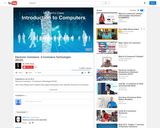
This is the software and IT systems that support transactions over networks. We look at: E-Commerce Hosts, Digital Money and Online Advertising.
This is out last video in the Introduction to Computers, BCIS, BIM series. We thank you for watching and look forward to seeing you in our next course.
Links from Video:
•What is Bitcoin? http://youtu.be/Gc2en3nHxA4
•Please Subscribe http://www.pleasesubscribefilm.com/
•http://www.storenvy.com/
•http://www.cafepress.com/

Word Count: 1879
(Note: This resource's metadata has been created automatically by reformatting and/or combining the information that the author initially provided as part of a bulk import process.)
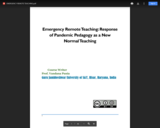
The main thrust is to explore conceptual foundation, instructional design, delivery mechanisms, Crisis Management, and Benchmark proposals for high-performing Emergency Remote Teaching plans. Since the Pedagogical Approach of ERT is also based on Humanizing Pedagogy and Pedagogy of Care to adapt to student needs, some other aspects include assessing the system’s current digital infrastructure (internet, device access), student and teacher digital capabilities, and budget availability must be considered while adopting emergency remote teaching. This work will prepare the school, university, and college teachers to acquire 21st-century skills and competence along with technology-supported pedagogical innovations based on different technologies, digital tools, and techniques to enrich the emergence of remote teaching experiences.

This is part 3 of a series of online exercises designed to demonstrate and allow students to practice what we consider the most useful, general functions of desktop EndNote for Windows. The online lessons and descriptive titles can be found in the Resources section, on the right side of your screen.Part 3 is concerned with using Cite While You Write (EndNote's plugin for Word) to place in-text citations into a Word document, change the referencing style to suit the student and build and edit the bibliography.Each lesson contains:general instructions describing what the student can expect to seespecific learning objectivesa main menu screen allowing them to choose between the demonstration and the practice exercisethe demonstration's duration timeThe demonstration part of each lesson:is narrated by the authoris not interactive includes text captionsThe practice part of each lesson:is not narrated contains more limited text prompts in place of detailed instructionsis interactiveThese lessons were created using Adobe Captivate 9 and published in HTML5 format, designed to be dropped into Moodle and used as HTML files. No grading or progress tracking is included in these lessons.They can be seen in action on KEATS (keats.kcl.ac.uk), the bespoke version of Moodle in use at King's College London. KEATS is not public, so please contact the authors for guest access or furher information regarding these lessons.

This is part 1 of a series of online exercises designed to demonstrate and allow students to practice what we consider the most useful, general functions of desktop EndNote for Windows. The online lessons and descriptive titles can be found in the Resources section, on the right side of your screen.Part 1 is focused on starting a new reference library and adding references from commonly used academic databases like OvidSP and CINAHL.Each lesson contains:general instructions describing what the student can expect to seespecific learning objectivesa main menu screen allowing them to choose between the demonstration and the practice exercisethe demonstration's duration timeThe demonstration part of each lesson:is narrated by the authoris not interactive includes text captionsThe practice part of each lesson:is not narrated contains more limited text prompts in place of detailed instructionsis interactiveThese lessons were created using Adobe Captivate 9 and published in HTML5 format, designed to be dropped into Moodle and used as HTML files. No grading or progress tracking is included in these lessons.They can be seen in action on KEATS (keats.kcl.ac.uk), the bespoke version of Moodle in use at King's College London. KEATS is not public, so please contact the authors for guest access or furher information regarding these lessons.

This is part 2 of a series of online exercises designed to demonstrate and allow students to practice what we consider the most useful, general functions of desktop EndNote for Windows. The online lessons and descriptive titles can be found in the Resources section, on the right side of your screen.Part 2 is concerned with adding references that come from non-database sources such as books (from a library catalogue) and webpages, what to do if your references are missing information and how to have EndNote find and attach journal article PDFs to your references. Each lesson contains:general instructions describing what the student can expect to seespecific learning objectivesa main menu screen allowing them to choose between the demonstration and the practice exercisethe demonstration's duration timeThe demonstration part of each lesson:is narrated by the authoris not interactive includes text captionsThe practice part of each lesson:is not narrated contains more limited text prompts in place of detailed instructionsis interactiveThese lessons were created using Adobe Captivate 9 and published in HTML5 format, designed to be dropped into Moodle and used as HTML files. No grading or progress tracking is included in these lessons.They can be seen in action on KEATS (keats.kcl.ac.uk), the bespoke version of Moodle in use at King's College London. KEATS is not public, so please contact the authors for guest access or furher information regarding these lessons.

The course is designed to equip students with knowledge and abilities in the use of word processing, presentation and spreadsheet applications. The focuses of the course are on the integration and hands-on training on word processing, presentation and spreadsheet applications in producing business documents, designing slides for presentations and apply spreadsheets documentation. Students will be able to demonstrate the keyboarding techniques in relations to applied management studies. The course also emphasizes on applying the applications learnt by working in a team to produce group project and presentations that meets an organization’s needs.

I use an "engaging question" on the first day of class in all of my courses. This activity is designed to be both engaging and central to all of the course content. That is, the activity is designed around questions that we can keep coming back to, over and over, after each learning unit. This approach not only provides a unifying focus for the course, but it also provides an opportunity to model critical thinking as we revisit the question each time with a different perspective. For the Dynamic Earth and Global Change (the Physical Geology course at Macalester) I chose a question about climate change. The activity starts with two graphs (plots of surface temperature and atmosphere CO2 composition for the past 1,000 years). Students are asked to describe the graphs, interpret the graphs, make some predictions, and explain the graphs using basic earth science processes.
(Note: this resource was added to OER Commons as part of a batch upload of over 2,200 records. If you notice an issue with the quality of the metadata, please let us know by using the 'report' button and we will flag it for consideration.)
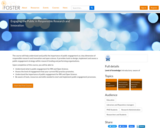
The course (supported by the European Union's Horizon 2020 Programme and Seventh Framework Programme) will help understand and justify the importance of public engagement as a key dimension of responsible research and innovation and open science. It provides tools to design, implement and assess a public engagement strategy within research funding and performing organizations.
Upon completion of this course, you will be able to:
Understand what is public engagement for RRI and Open Science.
Assess the level of engagement that your current R&I practice promotes.
Understand the importance of public engagement for RRI and Open Science.
Be aware of tools, resources and skills needed to start and implement public engagement processes.
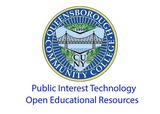
Engineering and Technology for the Better Good of Society PIT-OER is intended to train engineering technology students to leverage the power of select technologies aligned to the public interest applications and targeted public works institutions.This PIT-OER consists of four modules:Module 1: Project Management Methods with Applications to Public Works.Module 2: Technology and Ethics: “Are You Conflicted?”. Module 3: 3D Printing Applied to Everyday Public Interest and to Public Work Institutions.Module 4: How “Open” is Open Source Content: The Do’s and Don’t of Using Open Source Software, OSS. Each module is organized with lecture, assessment, and laboratory experiments. The modules are course materials for TECH-100, Introduction to Engineering and Technology, of Queensborough Community College.
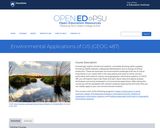
Increasingly volatile climate and weather; vulnerable drinking water supplies; shrinking wildlife habitats; widespread deforestation due to energy and food production. These are examples of environmental challenges that are of critical importance in our world, both in far away places and close to home, and are particularly well suited to inquiry using geographic information systems. In GEOG 487 you will explore topics like these and learn about data and spatial analysis techniques commonly employed in environmental applications. After taking this course you will be equipped with relevant analytical approaches and tools that you can readily apply to your own environmental contexts.
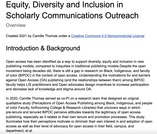
Open access has been identified as a way to support diversity, equity and inclusion in new publishing models, compared to inequities in traditional publishing models.Despite the open movement being decades old, there is still a gap in research on Black, Indigenous, and faculty of color (BIPOC) in the context of open access. Understanding the motivations for and barriers against Open Access (OA) publishing (and the relationships between them) among BIPOC faculty helps LIS practitioners and Open advocates design incentives to increase participation and decrease lack of knowledge and stigma around OA.
In 2020, Camille Thomas served as co-PI on a research team that designed an original qualitative study (Perceptions of Open Access Publishing among Black, Indigenous, and people of color Faculty, forthcoming College & Research Libraries) that uncovers ways in which pre-tenure and tenured BIPOC perceive attitudes towards the legitimacy of open access publishing, especially as it relates to their own tenure and promotion processes. This study illuminates how their perceptions motivate or diminish their own interest in and adoption of open access as well as their level of advocacy for open access in their field, campus, and department, et al.
To foster practical application of outreach needs based on responses from the study, this resource includes:
- Readings
- Discussion questions
- Sample Scenarios, Events and Initiatives
- Assignments
Assignments were specifically created for developing strategic initiatives and outreach to support marginalized scholars. While these materials do not seek to solve systemic issues in academic research, they will encourage building equitable open infrastructure and an inclusive culture when discussing open access at institutions. This resource provides hands-on assignments to integrate inclusive practices in outreach and technical work. It will prepare students for practical experience with open advocacy and encourage deliberate outreach planning, execution and assessment as scholarly communication continues to evolve.
Learning Objectives
To understand diverse needs of researchers and scholars based on their positionality and intersectionality (student, post-doc, research topics, discipline and departmental culture, identities)
To identify when encouraging open may harm researchers or communities
To develop messaging that highlights social justice through open access’ benefits of transparency, access and non-traditional formats
To develop strategic initiatives that address the unique needs of an institution and its surrounding community
To develop advocacy, leadership and management skills by planning, executing and assessing strategic initiatives

This video offers insight into the activities during the implementation of the Erasmus+ KA202 project "Future Trends in Clothing: Trendy, Smart and Healthy" (2018-2020).In this project three vocational schools from Austria, Spain, Germany cooperated with a general high school from Greece. The video is a documentation of the project's reached milestones, the great personal and work experiences we all gained during our international cooperation.It also shows how the work of everyone involved was still successfully concluded under the conditions of the Corona virus pandemic. Even if we where not able to manufacture & market our finalized product idea as planned, the skills we developed, shared and improved along the way are not less valuable.Now, enjoy the video and of course bear in mind ...“The European Commission support for the production of this publication does not constitute an endorsement of the contents which reflects the views only of the authors, and the Commission cannot be held responsible for any use which may be made of the information contained therein.”
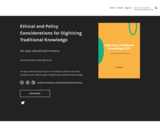
An open educational resource
Short Description:
An open educational resource to introduce ethical and policy considerations which apply to digitizing traditional knowledge.
Long Description:
Ethical and Policy Considerations for Digitizing Traditional Knowledge is a comprehensive instructional resource designed to introduce library professionals to the ethical and policy issues which accompany the digitization of traditional knowledge collections. This instructional resource includes a lesson plan, a slide deck, a case study with accompanying worksheet, and an annotated bibliography. Instructors will lead students through a lesson plan which includes identification of prior knowledge, direct instruction, guided practice and independent practice. Through this “I do, we do, you do” approach, students will learn about the definition of traditional knowledge, how and why it might be preserved, ethical considerations when preserving it, and examples of traditional knowledge collections. The resource also includes an opportunity for students to work through an authentic case study from a library which digitized a traditional knowledge collection. Using a worksheet that includes guided criteria, students can review the case study to determine how the community was considered within each stage of the digital content lifecycle. The resource also includes background reading on digitizing and preserving traditional knowledge with brief annotations for both instructors and students.
Word Count: 3900
(Note: This resource's metadata has been created automatically by reformatting and/or combining the information that the author initially provided as part of a bulk import process.)

Use this guide as an example of lateral reading.
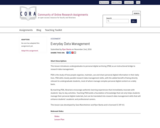
This lesson introduces undergraduates to personal digital archiving (PDA) as an instructional bridge to research data management.
PDA is the study of how people organize, maintain, use and share personal digital information in their daily lives. PDA skills closely parallel research data management skills, with the added benefit of being directly relevant to undergraduate students, most of whom manage complex personal digital content on a daily basis.
By teaching PDA, librarians encourage authentic learning experiences that immediately resonate with students' day-to-day activities. Teaching PDA builds a foundation of knowledge that not only helps students manage their personal digital materials, but can be translated into research data management skills that will enhance students' academic and professional careers.

The Evidence Based Medicine (EBM) Guide is designed to assist health care professionals and students become effective and efficient users of the medical literature. The guide provides an introduction to EBM and its core concepts. Topics include Levels of Evidence, Asking Clinical Questions, Searching PubMed, Clinical Filters, Additional Searching Techniques, Search Examples, Appraisal, and Pre-Appraised Summaries.
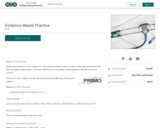
The Evidence-Based Practice lesson is mapped to the Research as Inquiry Frame and addresses how to match a clinical question to types of research evidence.
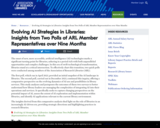
The onset of new, more accessible, artificial intelligence (AI) technologies marks a significant turning point for libraries, ushering in a period rich with both unparalleled opportunities and complex challenges. In this era of swift technological transformation, libraries stand at a critical intersection. To effectively chart this transition, two quick polls were conducted among members of the Association of Research Libraries (ARL).
The first poll, which ran in April 2023, provided an initial snapshot of the AI landscape in libraries. The second poll, carried out in December 2023, continued this inquiry, offering a comparative perspective on the evolving dynamics of AI use and possibilities in library services. This study analyzes and juxtaposes the outcomes of these two surveys to better understand how library leaders are managing the complexities of integrating AI into their operations and services. It specifically seeks to capture changing perspectives on the potential impact of AI, assess the extent of AI exploration and implementation within libraries, and identify AI applications relevant to the current library environment.
The insights derived from this comparative analysis shed light on the role of libraries in an increasingly AI-driven era, providing strategic directions and highlighting practices in research libraries.
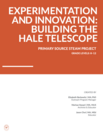
The primary sources in this project, drawn from the collections at the Rockefeller Archive Center, include correspondence and diagrams that document the process of fabricating what became a 200-inch Pyrex telescope mirror. These sources can be used to strengthen critical reading skills, to support inquiry-based learning exercises, and to expose students to the stories of trial and error that lie behind most scientific or engineering breakthroughs. Students are encouraged to annotate in the margins in order to support the development of document analysis and critical thinking skills. This project contains a suggested exercise that builds on the themes of the primary source documents.
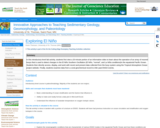
In this introductory-level lab activity, students first view a 20-minute portion of an informative video to learn about the operation of an array of moored buoys that is used to detect changes in the El NiÃo Southern Oscillation (El NiÃo, "normal", and La NiÃa conditions)in the equatorial Pacific Ocean. Students then directly access, display, and work with recent and present data collected from the buoy system using the Tropical Atmosphere Ocean project website. Finally, students examine data from a coral geochemical record to infer past ENSO events.
(Note: this resource was added to OER Commons as part of a batch upload of over 2,200 records. If you notice an issue with the quality of the metadata, please let us know by using the 'report' button and we will flag it for consideration.)
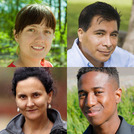
Extra credit assignment about the Cognitive Style Heuristics reading: https://www.oercommons.org/courses/reading-cognitive-style-heuristics
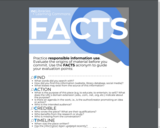
FACTS is an acroynm to help students remember key points when evaluating information.

This course provides a comprehensive review of interoperability, health data standards, and other advanced topics including Substitutable Medical Applications, Reusable Technologies (SMART) and Fast Healthcare Interoperability Resources® (FHIR), also known as SMART-on-FHIR applications and Accelerator projects. This course will use Interoperability Land™ to provide learners with a hands-on experience using FHIR resources. Upon successful completion of this course, learners will be able to: explain interoperability and use cases; locate information within JSON and XML files; Create queries in IOL; understand SMART application authorization. Interoperability Land can be purchased on AWS Marketplace at the followinglink: https://aws.amazon.com/marketplace/pp/prodview-f34r2uj3naohe For information regarding education pricing please email contactus@interoperabilityinstitute.org.
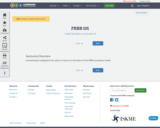
A presentation designed to be used in a lesson on the basics of the FRBR conceptual model
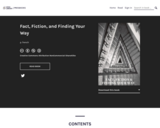
Word Count: 15347
(Note: This resource's metadata has been created automatically by reformatting and/or combining the information that the author initially provided as part of a bulk import process.)

Word Count: 13335
(Note: This resource's metadata has been created automatically by reformatting and/or combining the information that the author initially provided as part of a bulk import process.)

NSCC EDITION
Short Description:
The Faculty OER Toolkit is an information resource about and guide to adapting and adopting Open Educational Resources. Included are definitions and examples, information about Creative Commons licensing, and tips on how to adapt and/or adopt OER for classroom use.
Long Description:
The Faculty OER Toolkit is an information resource about and guide to adapting and adopting Open Educational Resources. Included are definitions and examples, information about Creative Commons licensing, and tips on how to adapt and/or adopt OER for classroom use.
Word Count: 4518
ISBN: 978-1-77420-044-5
(Note: This resource's metadata has been created automatically by reformatting and/or combining the information that the author initially provided as part of a bulk import process.)

Short Description:
The Faculty OER Toolkit is an information resource about and guide to adapting and adopting Open Educational Resources. Included are definitions and examples, information about Creative Commons licensing, and tips on how to adapt and/or adopt OER for classroom use.
Long Description:
The Faculty OER Toolkit is an information resource about and guide to adapting and adopting Open Educational Resources. Included are definitions and examples, information about Creative Commons licensing, and tips on how to adapt and/or adopt OER for classroom use.
Word Count: 4522
ISBN: 978-1-77420-044-5
(Note: This resource's metadata has been created automatically by reformatting and/or combining the information that the author initially provided as part of a bulk import process.)

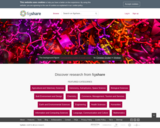
Figshare is a repository where users can make all of their research outputs available in a citable, shareable and discoverable manner. Figshare allows users to upload any file format to be previewed in the browser so that any research output from posters and presentations to datasets and code, can be disseminated in a way that the current scholarly publishing model does not allow.
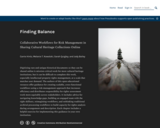
Collaborative Workflows for Risk Management in Sharing Cultural Heritage Collections Online
Short Description:
Digitizing rare and unique historical documents so they can be shared online is mission-critical work for most cultural heritage institutions, but it can be difficult to complete this work, especially intellectual property rights management, at a scale that matches user demand. The authors of this open educational resource offer guidance for creating scalable, cross-functional workflows using a risk-management approach that increases efficiency and distributes responsibility for rights assessment work more equitably across stakeholders. It includes advice for navigating knowledge gaps, building an engaged team with the right skillsets, reimagining workflows, and rethinking traditional archival processing workflows to build capacity for rights analysis during arrangement and description. Each chapter includes a helpful exercise for implementing this guidance in your own institution.
Word Count: 28621
(Note: This resource's metadata has been created automatically by reformatting and/or combining the information that the author initially provided as part of a bulk import process.)

An overview of print books and how to find them. Includes informatoin on reference materials and Boolean searching. Videos are close-captioned.
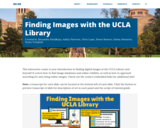
This interactive comic is your introduction to finding digital images at the UCLA Library and beyond! It covers how to find image databases and online exhibits, as well as how to approach searching for and citing online images. Check out the comic’s embedded links for additional info!

This resource was initially created to help creative arts students critically engage with referencing and citation politics and celebrate in time for Eurovision in May 2021!
Five things you can learn from Eurovision about referencing include:
1. Both referencing and Eurovision are political
2. Question power and privilege and amplify diverse voices
3. Prioritise quality over quantity of sources and focus on content more than staging or style
4. Record and backup sources so you can learn from the past
5. Inspired by this year’s Eurovision theme Open Up, support open scholarship

Short Description:
Foundations of Biomedical Science: Quantitative Literacy Theory and Problems is designed to help students develop the fundamental mathematical and quantitative literacy required to navigate and interpret evidence-based Biomedical data. This will provide students with the skills and confidence to habitually question any quantitative data they come across and to use these skills to make informed judgements regarding their veracity.
Long Description:
Modern Biomedicine is evidence-based, which means it is underpinned by quantitative data. Recent technological advances have led to Biomedicine (and Biology in general) becoming more “data driven” and hence more quantitative and predictive. Hence, now more than ever, an understanding of quantitative data is crucial for students of Biomedical disciplines.
Foundations of Biomedical Science: Quantitative Literacy Theory and Problems is designed to help students develop the fundamental mathematical and quantitative literacy required to navigate and interpret evidence-based Biomedical data. This ebook is divided into short chapters, each containing a concise summary of: theory provided through a Biomedical context authentic worked examples, problem sets and solutions further extension and application of the theory.
These chapters build to provide students with the skills and confidence to habitually question any quantitative data they come across and to use these skills to make informed judgements regarding their veracity.
Word Count: 69830
ISBN: 978-0-6484681-8-9
(Note: This resource's metadata has been created automatically by reformatting and/or combining the information that the author initially provided as part of a bulk import process.)
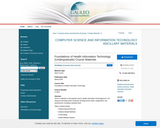
This is a collection of all materials used in Health Information Technology by Dr. Chi Zhang at Kennesaw State University, including lecture slides, assignments, and assessments, including a question bank.
Topics covered include:
Clinical Financial Records
Evidence-Based Medicine
e-Prescribing
Patient Bedside Systems
Telemedicine
Health Information Networks
Cryptography
Accreditation
HIPAA Privacy and Security
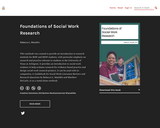
Short Description:
This textbook was created to provide an introduction to research methods for BSW and MSW students, with particular emphasis on research and practice relevant to students at the University of Texas at Arlington. It provides an introduction to social work students to help evaluate research for evidence-based practice and design social work research projects. It can be used with its companion, A Guidebook for Social Work Literature Reviews and Research Questions by Rebecca L. Mauldin and Matthew DeCarlo, or as a stand-alone textbook.
Word Count: 108842
ISBN: 978-1-64816-991-5
(Note: This resource's metadata has been created automatically by reformatting and/or combining the information that the author initially provided as part of a bulk import process.)
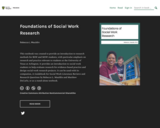
Short Description:
This textbook was created to provide an introduction to research methods for BSW and MSW students, with particular emphasis on research and practice relevant to students at the University of Texas at Arlington. It provides an introduction to social work students to help evaluate research for evidence-based practice and design social work research projects. It can be used with its companion, A Guidebook for Social Work Literature Reviews and Research Questions by Rebecca L. Mauldin and Matthew DeCarlo, or as a stand-alone textbook.
Word Count: 111030
ISBN: 978-1-64816-991-5
(Note: This resource's metadata has been created automatically by reformatting and/or combining the information that the author initially provided as part of a bulk import process.)
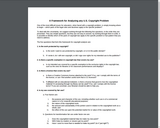
One of the most difficult issues for educators, when faced with a copyright problem, is simply knowing where
to begin -- which parts of the legal rules and doctrines apply to the specific problem? To deal with this uncertainty, we suggest working through the following five questions, in the order they are presented. They are simple questions, but they are not easy to answer; by working through them in order, it is possible to identify which of the parts of copyright law apply to the specific problem or fact pattern that you need to address.

a primer for employees of Ontario Universities and Colleges
Word Count: 3083
(Note: This resource's metadata has been created automatically as part of a bulk import process by reformatting and/or combining the information that the author initially provided. As a result, there may be errors in formatting.)
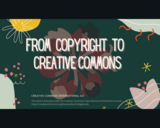
A brief overview of the history of copyright laws and why the Creative Commons was right on time!
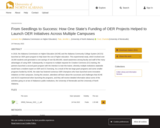
In 2018, the Alabama Commission on Higher Education (ACHE) and the Alabama Community College System (ACCS) launched an OER grant program to help lower the cost of higher education. This experimental study, which involved over 18,000 students and generated a cost savings of over $2,000,000, raised awareness among faculty and staff of the many advantages of using OER. Subsequently, in response to multiple requests for Creative Commons (CC) training, the partners launched a second grant program with the intention to train-the-trainer, whereby multiple institutions statewide would have a resident expert on OER and CC licensing. As a result of the two large grant programs and some smaller programs funded by ACHE, the state has fostered numerous OER champions who have launched some innovative initiatives on their campuses. During this session, attendees will learn about the successes and challenges that ACHE and ACCS experienced when launching the programs, and they will receive detailed information about some of the activities going on at two of Alabama’s public institutions, the University of Montevallo and the University of North Alabama.
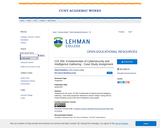
Case Study Assignment for the course: CIS 356 - Fundamentals of Cybersecurity and Intelligence Gathering. Delivered at Lehman College in Spring 2020 by Fahad Chowdhury as part of the Tech-in-Residence Corps program.
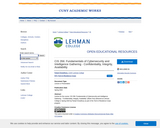
Lecture #1 for the course: CIS 356 - Fundamentals of Cybersecurity and Intelligence Gathering. Delivered at Lehman College in Spring 2020 by Fahad Chowdhury as part of the Tech-in-Residence Corps program.
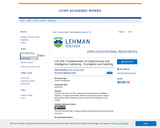
Lecture #4 for the course: CIS 356 - Fundamentals of Cybersecurity and Intelligence Gathering. Delivered at Lehman College in Spring 2020 by Fahad Chowdhury as part of the Tech-in-Residence Corps program.
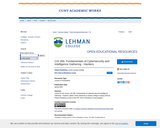
Lecture #3 for the course: CIS 356 - Fundamentals of Cybersecurity and Intelligence Gathering. Delivered at Lehman College in Spring 2020 by Fahad Chowdhury as part of the Tech-in-Residence Corps program.
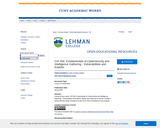
Lecture #2 for the course: CIS 356 - Fundamentals of Cybersecurity and Intelligence Gathering. Delivered at Lehman College in Spring 2020 by Fahad Chowdhury as part of the Tech-in-Residence Corps program.

The freely accessible moodle platform offers a number of insights into past proejct work as well as a documentation of the results that were achieved in the course of the project.
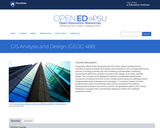
Geography 468 provides the geospatial information system professional an overview of systems analysis and design with emphasis on the concepts behind the process, including: business use case modeling, business object modeling, requirements definition, analysis and preliminary design, and, finally, detailed design. The concepts of the geospatial software and database development process are introduced and the current modeling techniques are addressed within the geospatial systems development paradigm. In a series of related activities, students learn about the methods, tools and the concepts of the systems development process to document a portion of a geospatial system with Unified Modeling Language (UML), the standard graphical notation for modeling application needs.
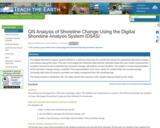
The Digital Shoreline Analysis System (DSAS) is a software extension for ArcGIS that allows for automated shoreline change calculations along the coast. The user must supply the shoreline data and the software helps the user create measurement locations (transects) and completes the shoreline change calculations at each location. The result is a visual representation of the shoreline change along a coastline. This representation is far more useful for analysis that one overall average. Unusually high rates of erosion/accretion are easily recognized from the resulting map.
The study location is Rodanthe, NC. The data used in this exercise is the sample data provided by the USGS.
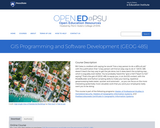
Bill Gates is credited with saying he would \hire a lazy person to do a difficult job\" with the justification that \"a lazy person will find an easy way to do it.\" GEOG 485 doesn't teach the lazy way to get the job done, but it does teach the scripting way _ which is arguably even better. You've probably heard the \"give a fish\"/\"teach to fish\" saying? That's the gist of GEOG 485: to equip you, in an ArcGIS context, with the ModelBuilder and Python scripting skills to make your boring, repetitive geoprocessing tasks easier, quicker and automatic _ so you can focus on the more interesting (potentially more valuable) work that you (and your employers) really want you to be doing."
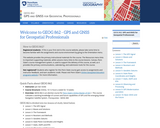
Today GPS is critical to positioning, navigation, and timing. The smooth functioning of financial transactions, air traffic, ATMs, cell phones and modern life in general around the world depend on GPS. This very criticality requires continuous modernization. The oldest satellites in the current constellation were launched in the 1990s. If you imagine using a computer of that vintage today, it is not surprising that the system is being substantially updated. Global Positioning System (GPS) is now a part of a growing international con?text-the Global Navigation Satellite System, GNSS. This course dives into how GPS and other GNSS systems are designed, how they operate, and the impacts they have on spatial analysis and spatially-enabled systems.

This module illusrates navigation to and use of Gale PowerSearch from the Alabama Virtual Library. All videos are closed-captioned.

This course introduces students to the rudiments of game theory as practiced in political science. It teaches students the basic elements of formal modeling and strategies for solving simple games. Readings draw from introductory texts on game theoretic modeling and applied articles in American politics, international relations, and comparative politics.
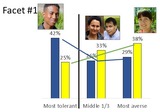
Useful graphics and slides for dispelling fears about GenderMag and stereotyping.
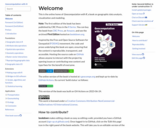
This book is about using the power of computers to do things with geographic data. It teaches a range of spatial skills, including: reading, writing and manipulating geographic data; making static and interactive maps; applying geocomputation to solve real-world problems; and modeling geographic phenomena. By demonstrating how various geographic operations can be linked, in reproducible ‘code chunks’ that intersperse the prose, the book also teaches a transparent and thus scientific workflow. Learning how to use the wealth of geospatial tools available from the R command line can be exciting, but creating new ones can be truly liberating. Using the command-line driven approach taught throughout, and programming techniques covered in Chapter 11, can help remove constraints on your creativity imposed by software. After reading the book and completing the exercises, you should therefore feel empowered with a strong understanding of the possibilities opened up by R’s impressive geographic capabilities, new skills to solve real-world problems with geographic data, and the ability to communicate your work with maps and reproducible code.
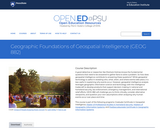
A good detective or researcher like Sherlock Holmes knows the fundamental questions that need to be answered to gather facts to solve a problem. So how does geospatial intelligence contribute to answering these questions? While geospatial technology is useful in revealing who, what, when, and where events take place, it is less useful in explaining why events occur. However, geospatial intelligence analysis leverages geographic information science and technology with the intelligence tradecraft to develop products that support decision-making in national and homeland security, law enforcement, emergency management, and international relief efforts. GEOG 882 will challenge you to think critically, consider alternative viewpoints, and question your own assumptions when analyzing why human events occur over place and time.
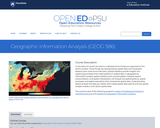
In this data rich world, we need to understand how things are organized on the Earth's surface. Those things are represented by spatial data and necessarily depend upon what surrounds them. Spatial statistics provide insights into explaining processes that create patterns in spatial data. In geographical information analysis, spatial statistics such as point pattern analysis, spatial autocorrelation, and spatial interpolation will analyze the spatial patterns, spatial processes, and spatial association that characterize spatial data. Understanding spatial analysis will help you realize what makes spatial data special and why spatial analysis reveals a truth about spatial data.
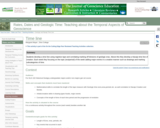
This lab serves to introduce students to geologic time and serves as an outline for the course through the semester.
Students use a tape register and must mark out the corresponding length of each Geologic Era and Eon towards the beginning of the course. Above Western time line Navajo students construct their own time line correlating events as best as possible. As the course progresses starting from 4.6bya each week they must draw major events that occur marking correct subdivisions of time and ages ago. As fossil life gets more complex such as beginning in the Paleozoic students are must take different categories of fossils or different periods so all are doing different things but working together. (Similarly the Navajo time line builds. This time line is taped around the room---and I would have liked to paint the two time lines along the corridor of the building but Maintenance axed it.
(Note: this resource was added to OER Commons as part of a batch upload of over 2,200 records. If you notice an issue with the quality of the metadata, please let us know by using the 'report' button and we will flag it for consideration.)
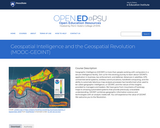
Geographic Intelligence (GEOINT) is more than people working with computers in a secure intelligence facility. Join us for this exciting journey to learn about GEOINT's application in business, law enforcement, and defense. Advances in satellites, GPS, unmanned aerial systems, wireless communications, handheld computing, and the ability to automate laborious map analysis processes has transformed what used to be called geographic intelligence, or GEOINT, and the nature of the insights provided to managers and leaders. We have gone from mountains of hardcopy maps to amazing automated systems that provide previously unavailable understanding. GEOINT combines geographic information science and technologies with an analytic tradecraft. You will experience the value of GEOINT. We welcome you to the Revolution.
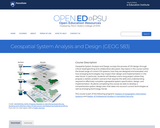
Geospatial System Analysis and Design surveys the process of GIS design through critical reading/writing and collaborative discussion. Key topics in the course outline the broad range of current GIS systems, how they are designed and evaluated, and how emerging technologies may impact their design and implementation in the near future. In particular, students will develop a term-long project where they propose a realistic problem scenario that requires the skills and understanding required to effectively complete a geospatial system specification, design, and implementation. Students completing this course are able to develop a comprehensive system design plan that takes into account current technologies as well as emerging technology trends.
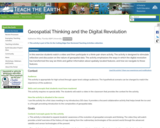
In this exercise students watch a video and then participate in a think-pair-share activity. The activity is designed to stimulate reflection and discussion on the nature of geospatial data. The activity emphasizes the ways in which the digital revolution has transformed the way we think and gather information about spatially located features, and how we navigate to those features.
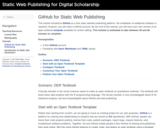
This tutorial introduces GitHub as a free static website publishing platform. No installation of additional software is required, however, you will need a GitHub account. By the end of this tutorial, you will have your own version of an open textbook template available for further editing. This tutorial is estimated to take between 30 and 60 minutes to complete.
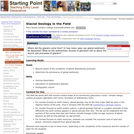
Students describe and interpret glacial features exposed in gravel pits and outcrops.
(Note: this resource was added to OER Commons as part of a batch upload of over 2,200 records. If you notice an issue with the quality of the metadata, please let us know by using the 'report' button and we will flag it for consideration.)

Detailed, annotated example of Socratic questioning for topics of climate change, global warming, and greenhouse gases in the atmosphere.
(Note: this resource was added to OER Commons as part of a batch upload of over 2,200 records. If you notice an issue with the quality of the metadata, please let us know by using the 'report' button and we will flag it for consideration.)
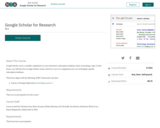
Google Scholar can be a valuable complement to your institution’s subscription databases when researching a topic. In this lesson, you will learn how Google Scholar works, and how to use it to complement your use of discipline-specific subscription databases.

A project-based approach
Short Description:
This textbook guides graduate students in education step by step through the research process from conceptualization to dissemination. Recommended citation: DeCarlo, M., Cummings, C., Agnelli, K., & Laitsch, D. (2022, June 28). Graduate research methods in education (leadership): A project-based approach (Version 2.12.14.17-19.22). BC Campus. https://pressbooks.bccampus.ca/dlaitsch/
Word Count: 276805
(Note: This resource's metadata has been created automatically by reformatting and/or combining the information that the author initially provided as part of a bulk import process.)

This book has moved to https://pressbooks.bccampus.ca/dlaitsch.
Short Description:
This textbook guides graduate students in education step by step through the research process from conceptualization to dissemination.
Word Count: 276947
(Note: This resource's metadata has been created automatically by reformatting and/or combining the information that the author initially provided as part of a bulk import process.)

A project-based approach
Short Description:
This is a pre-release preview of a textbook that will be published in August 2020. Faculty considering adopting the textbook should browse this pre-release edition, as only small changes will be made between now and publication. For more information and ancillary resources contact profmattdecarlo@gmail.com.Our textbook guides students, step-by-step through the process of conducting a student research project--conducting a literature review, conceptualizing a research question, designing a research project, collecting and analyzing quantitative and qualitative data, as well as disseminating results to academic and lay audiences. The textbook emphasizes ethics, cultural humility, social justice, information literacy, and feasibility as core components of the research process.
Word Count: 250919
(Note: This resource's metadata has been created automatically by reformatting and/or combining the information that the author initially provided as part of a bulk import process.)

A project-based approach
Short Description:
Our textbook guides graduate social work students step by step through the research process from conceptualization to dissemination. We center cultural humility, information literacy, pragmatism, and ethics and values as core components of social work research.
Word Count: 279802
(Note: This resource's metadata has been created automatically by reformatting and/or combining the information that the author initially provided as part of a bulk import process.)
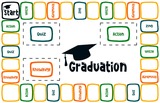
Graduation is a board game designed to teach the frame "Information Has Value" from the Association of College and Research Libraries' Framework for Information Literacy for Higher Education (2015). Created by students in ISI 6372 Information Literacy at the University of Ottawa, Winter 2020.

O guia foi criado a fim de apresentar as funcionalidades do app, bem como as tecnologias empregadas no desenvolvimento do mesmo.
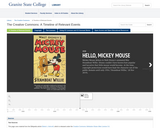
This guide covers the history of the Creative Commons, how and why it was established and what the CC licenses can do for creators and authors.

Une liste en développement de ressources éducatives libres (REL) suggérées pour les cours à l'Université d'Ottawa
Short Description:
Le Guide REL par discipline est un outil en développement qui offre des suggestions de ressources éducatives libres pour les cours à uOttawa. Cette version n'est plus à jour. Consultez plutôt version 2.0 - juin 2022.
Long Description:
Le Guide REL par discipline : Université d’Ottawa est un outil en développement offrant des suggestions de ressources éducatives libres pour des cours spécifiques à uOttawa. L’objectif est d’aider les professeurs à se familiariser avec les REL existantes dans leurs discplines et de faciliter leur utilisation. Le guide sera mis à jour sur une base annuelle au fur et à mesure que de nouvelles ressources sont identifiées. Cette version n’est plus à jour. Consultez plutôt version 2.0 – juin 2022.
Word Count: 6508
(Note: This resource's metadata has been created automatically by reformatting and/or combining the information that the author initially provided as part of a bulk import process.)

Une liste de ressources éducatives libres (REL) suggérées pour les cours à l'Université d'Ottawa
Short Description:
Le Guide REL par discipline est un outil qui offre des suggestions de ressources éducatives libres pour les cours à uOttawa. Cette version remplace version 1.0 – juin 2021. Consultez cette version en ligne pour les plus récentes mises à jour. Il existe aussi une version anglaise de ce guide : OER by Discipline Guide: University of Ottawa (Version 2.0 - June 2022). Vous utilisez déjà une REL dans votre cours ? Dites-le nous en remplissant le formulaire d'adoption.
Long Description:
Le Guide REL par discipline : Université d’Ottawa est un outil offrant des suggestions de ressources éducatives libres pour des cours spécifiques à uOttawa. L’objectif est d’aider le corps professoral et le personnel enseignant (ainsi que la population étudiante) à se familiariser avec les REL existantes dans leurs disciplines et de faciliter leur utilisation. Cette version remplace version 1.0 – juin 2021. Consultez cette version en ligne pour les plus récentes mises à jour.
Il existe aussi une version anglaise de ce guide : OER by Discipline Guide: University of Ottawa (Version 2.0 – June 2022).
Vous utilisez déjà une REL dans votre cours ? Dites-le nous en remplissant le formulaire d’adoption.
Word Count: 22793
(Note: This resource's metadata has been created automatically by reformatting and/or combining the information that the author initially provided as part of a bulk import process.)
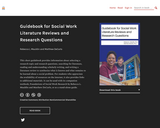
Short Description:
This short guidebook provides information about selecting a research topic and research questions, searching for literature, reading and understanding scholarly writing, and writing a literature review to synthesize what is known and what remains to be learned about a social problem. For students who appreciate the availability of resources on the internet, it also provides links to additional materials. It can be used with its companion textbook, Foundations of Social Work Research by Rebecca L. Mauldin and Matthew DeCarlo, or as a stand-alone guide.
Long Description:
As an introductory textbook for social work students studying research methods, this book guides students through the process of writing a literature review and determining research questions for a research project. Students will learn how to discover a researchable topic that is interesting to them, examine scholarly literature, and write a literature review. The guidebook is aligned with the Council on Social Work Education’s 2015 Educational Policy and Accreditation Standards. Students and faculty can download copies of this guidebook using the links provided in the front matter. As an open textbook, users are free to retain copies, redistribute copies (non-commercially), revise the contents, remix it with other works, and reuse for any purpose.
Word Count: 31630
ISBN: 978-1-64816-992-2
(Note: This resource's metadata has been created automatically by reformatting and/or combining the information that the author initially provided as part of a bulk import process.)

An 18-panel comic strip explaining the concept of netiquette.

Doing a MOOC or an Online Course is like booking a cab or ordering food online. There is an unprecedented expansion and ease. But the same way we see the limitations and see there are haves and have-nots in this COVID-stricken damaged world, we need to know that many of us do not know good enough about MOOCs as well. Apart from the update to you that even you can host and launch an Online Course, let us share a good platform of free MOOCs- HP EdcastCloud.

One-page definitions sheet.

Very short form for collecting in-class questions and comments about GenderMag.
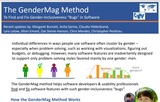
Two-page summary of the GenderMag walkthrough method.

Applying the latest research to a clinical question is a vital skill for any evidence-based practitioner. These five Health Research Readiness modules introduce you to essential health information resources and equip you with the skills to efficiently find, evaluate, and reference them. Relevant for undergraduates, postgraduates, or anyone wanting to improve their health sciences information skills.
The five modules include:
Module A: Sources of information
Module B: Types of information
Module C: Searching
Module D: Evaluating information
Module E: Referencing

In this session you will be introduced to the methods and dynamics of relevance for health promotion on social media with specific focus on the role and impact of fake health science . The exercise is based on a simulation game where students will join an already established secret Facebook group.
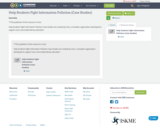
**The publisher of this resource is Civix.Help Students Fight Information Pollution Case Studies are created by Civix, a Canadian organization developed to support civics and media literacy education